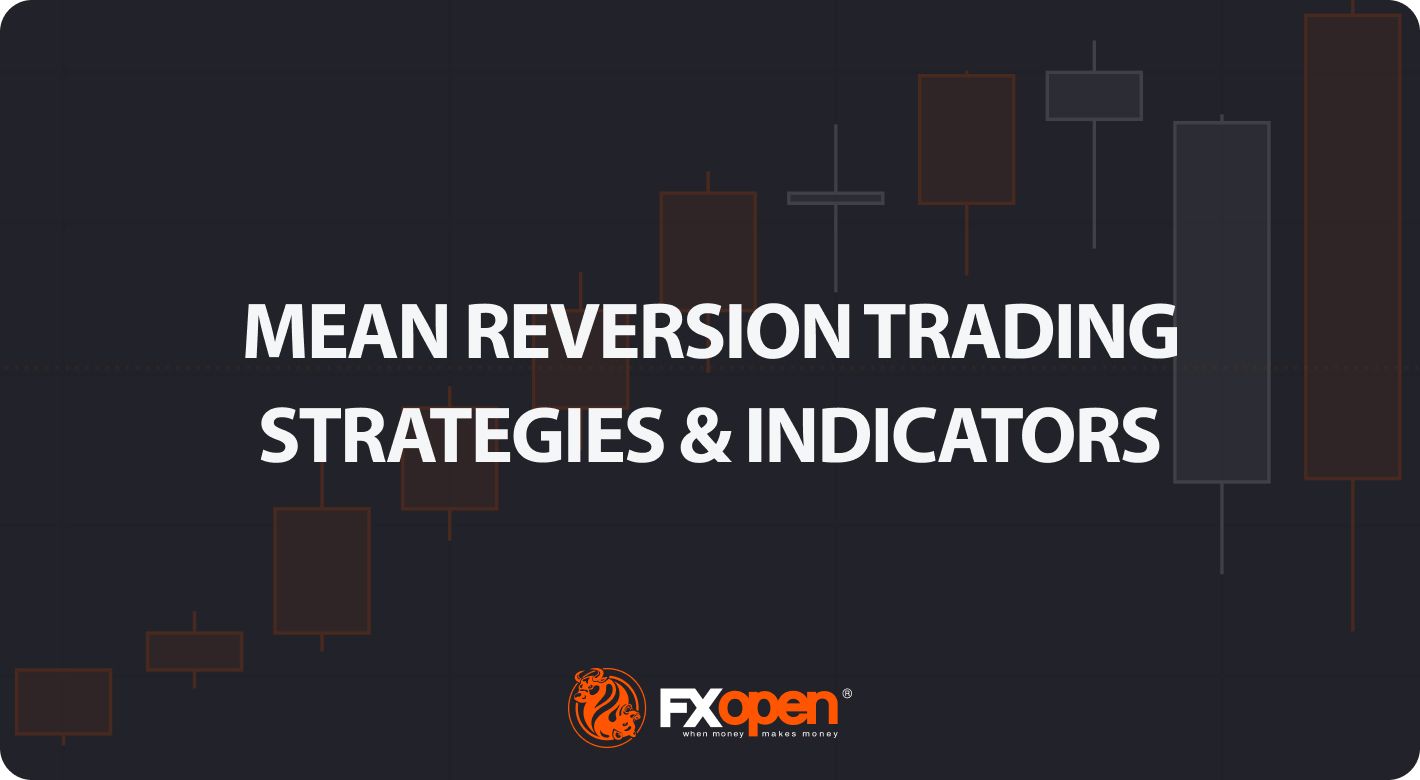FXOpen

Mean reversion is an important concept in financial markets, offering traders the opportunity to capitalise on price fluctuations around a long-term average. This article unpacks mean reversion and explores three key trading strategies augmented by specific indicators to fine-tune entry and exit points.
Understanding Mean Reversion
Mean reversion is a theory suggesting that asset prices and historical returns eventually revert to their long-term mean or average level. This concept is widely used in the equity markets, commodities, and forex trading. The idea is that an asset that has deviated significantly from its historical average is likely to revert back. Traders often use mean reversion trading systems to take advantage of these deviations.
Mean reversion in forex is particularly fascinating. Currency pairs tend to oscillate around a central point over time, offering plenty of trading opportunities. The concept relies on two core assumptions: that the market is stable over the long term and that temporary disruptions will self-correct. However, it's essential to remember that mean reversion is not foolproof. Market conditions change, and an asset can maintain its deviated state longer than one might expect.
Exploring Mean Reversion Trading Strategies
Now that we've established a foundational understanding of mean reversion, let's delve into three distinct reversion to the mean trading strategies. If you’d like to follow along, head over to FXOpen’s free TickTrader platform to access the tools discussed here.
10-Period RSI Mean Reversion
The 10-period RSI Mean Reversion trading strategy involves the Relative Strength Index (RSI), a momentum oscillator that measures the speed and change of price movements. For this strategy, traders typically set the RSI to a 10-period setting and establish overbought and oversold limits at 80 and 20, respectively. By focusing on shorter intervals, this strategy aims to capture quick reversals in price.
Entry
Traders may look for the RSI to reach or exceed 80 (overbought) or drop to 20 or lower (oversold). After reaching these levels, they often wait for the RSI to move back below 80 or above 20 before entering a trade.
Stop Loss
A common approach is to set the stop loss just beyond the entry point to minimise potential losses.
Take Profit
The trade is generally closed when the RSI reaches the midpoint of 50. This often indicates that the asset has reverted to its mean, fulfilling the primary objective of the strategy.
Fibonacci Retracement and Value Area Reversion
This strategy combines Fibonacci Retracement levels with a Fixed Range Volume Profile (FRVP) to identify potent entry and exit points. Fibonacci Retracement is a tool that identifies potential levels where price may reverse during a pullback. Here, traders focus on three key retracement levels: 38.2%, 50%, and 61.8%.
The Fixed Range Volume Profile, on the other hand, reveals where the highest volume of trades occurred within a specific range, indicating a value area. Traders look at the largest node as an area of value, often serving as a strong support or resistance level.
Entry
Traders often look for an established trend, typically entering positions in the same direction.
After a breakout, they commonly wait for a pullback to a Fibonacci level that aligns with the value area determined by FRVP.
Stop Loss
Stop losses are usually placed just beyond the next closest Fibonacci retracement level to safeguard against unforeseen reversals.
Take Profit
Profits are often taken at the most recent significant high or low, generally, the one that initiated a reversal.
VWAP and MACD Reversion: A Day Trading Mean Reversion Strategy
In this strategy, the Volume Weighted Average Price (VWAP) is used alongside the Moving Average Convergence Divergence (MACD). VWAP serves as a benchmark, calculating the average price based on volume at each price level. This indicator is often employed for intraday trading due to its responsiveness to immediate price and volume changes.
MACD, on the other hand, is a trend-following momentum indicator that helps signify potential price reversals. Due to the intraday nature of the VWAP, this strategy is particularly well-suited for day trading, enabling traders to capitalise on fairly quick, mean-reverting price movements.
Entry
Traders often monitor for situations where the price appears visually overextended from the VWAP, either above or below it.
A MACD crossover serves as the cue for possible entry, indicating that the price may revert toward the VWAP.
Stop Loss
Typically, stop losses are set just beyond the most recent swing point to mitigate risk.
Take Profit
The position is commonly closed when the price reaches the VWAP.
In the event that the price doesn’t touch the VWAP before the trading day ends, trades can be closed just before the day finishes when the VWAP is reset.
Additional Mean Reversion Indicators
While the strategies outlined above are popular among traders, there are other indicators worth considering in the realm of mean reversion.
- Bollinger Bands: These are volatility bands that expand and contract around a moving average. When the price reaches the upper or lower band, a mean-reverting move could be imminent.
- Moving Averages: Simple moving averages (SMAs) and exponential moving averages (EMAs) are often used in mean reversion and algorithmic trading. They help identify the 'mean' price level around which an asset is expected to fluctuate.
- Stochastic Oscillator: This momentum indicator compares an asset's closing price to its price range over a specific period. An overbought or oversold reading suggests that a mean reversion may be likely.
- CCI (Commodity Channel Index): This indicator measures the deviation of an asset’s price from its average price over a specific time period. CCI can be used to detect overbought or oversold markets.
- MFI (Money Flow Index): This is a volume-weighted RSI, indicating overbought and oversold conditions. When used in conjunction with other indicators, it can provide additional validation for mean reversion trades.
The Bottom Line
In sum, mean reversion trading strategies offer intriguing avenues for traders to exploit price movements that deviate from long-term averages. While the strategies discussed are robust, they are by no means exhaustive. To delve deeper into these and other trading strategies, consider opening an FXOpen account, where you’ll gain access to a host of advanced tools and analytics to aid in your trading endeavours. Good luck!
This article represents the opinion of the Companies operating under the FXOpen brand only. It is not to be construed as an offer, solicitation, or recommendation with respect to products and services provided by the Companies operating under the FXOpen brand, nor is it to be considered financial advice.
Stay ahead of the market!
Subscribe now to our mailing list and receive the latest market news and insights delivered directly to your inbox.








